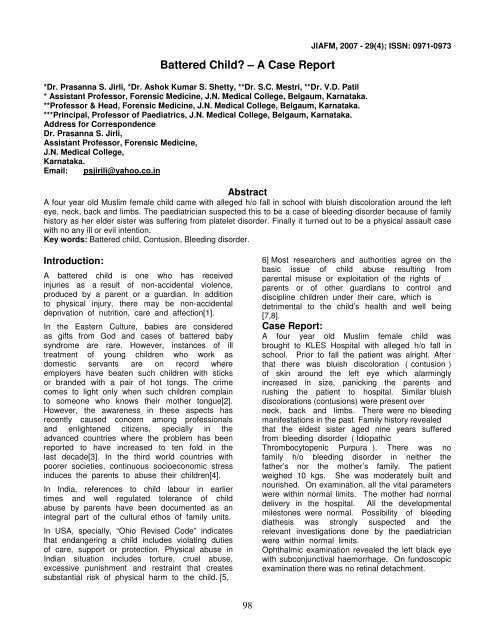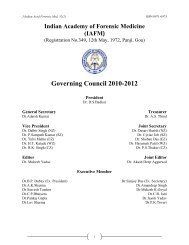Download - forensic medicine
Download - forensic medicine
Download - forensic medicine
You also want an ePaper? Increase the reach of your titles
YUMPU automatically turns print PDFs into web optimized ePapers that Google loves.
Battered Child? – A Case Report<br />
*Dr. Prasanna S. Jirli, *Dr. Ashok Kumar S. Shetty, **Dr. S.C. Mestri, **Dr. V.D. Patil<br />
* Assistant Professor, Forensic Medicine, J.N. Medical College, Belgaum, Karnataka.<br />
**Professor & Head, Forensic Medicine, J.N. Medical College, Belgaum, Karnataka.<br />
***Principal, Professor of Paediatrics, J.N. Medical College, Belgaum, Karnataka.<br />
Address for Correspondence<br />
Dr. Prasanna S. Jirli,<br />
Assistant Professor, Forensic Medicine,<br />
J.N. Medical College,<br />
Karnataka.<br />
Email: psjirili@yahoo.co.in<br />
JIAFM, 2007 - 29(4); ISSN: 0971-0973<br />
Abstract<br />
A four year old Muslim female child came with alleged h/o fall in school with bluish discoloration around the left<br />
eye, neck, back and limbs. The paediatrician suspected this to be a case of bleeding disorder because of family<br />
history as her elder sister was suffering from platelet disorder. Finally it turned out to be a physical assault case<br />
with no any ill or evil intention.<br />
Key words: Battered child, Contusion, Bleeding disorder.<br />
Introduction:<br />
A battered child is one who has received<br />
injuries as a result of non-accidental violence,<br />
produced by a parent or a guardian. In addition<br />
to physical injury, there may be non-accidental<br />
deprivation of nutrition, care and affection[1].<br />
In the Eastern Culture, babies are considered<br />
as gifts from God and cases of battered baby<br />
syndrome are rare. However, instances of ill<br />
treatment of young children who work as<br />
domestic servants are on record where<br />
employers have beaten such children with sticks<br />
or branded with a pair of hot tongs. The crime<br />
comes to light only when such children complain<br />
to someone who knows their mother tongue[2].<br />
However, the awareness in these aspects has<br />
recently caused concern among professionals<br />
and enlightened citizens, specially in the<br />
advanced countries where the problem has been<br />
reported to have increased to ten fold in the<br />
last decade[3]. In the third world countries with<br />
poorer societies, continuous socioeconomic stress<br />
induces the parents to abuse their children[4].<br />
In India, references to child labour in earlier<br />
times and well regulated tolerance of child<br />
abuse by parents have been documented as an<br />
integral part of the cultural ethos of family units.<br />
In USA, specially, “Ohio Revised Code” indicates<br />
that endangering a child includes violating duties<br />
of care, support or protection. Physical abuse in<br />
Indian situation includes torture, cruel abuse,<br />
excessive punishment and restraint that creates<br />
substantial risk of physical harm to the child. [5,<br />
6] Most researchers and authorities agree on the<br />
basic issue of child abuse resulting from<br />
parental misuse or exploitation of the rights of<br />
parents or of other guardians to control and<br />
discipline children under their care, which is<br />
detrimental to the child’s health and well being<br />
[7,8].<br />
Case Report:<br />
A four year old Muslim female child was<br />
brought to KLES Hospital with alleged h/o fall in<br />
school. Prior to fall the patient was alright. After<br />
that there was bluish discoloration ( contusion )<br />
of skin around the left eye which alarmingly<br />
increased in size, panicking the parents and<br />
rushing the patient to hospital. Similar bluish<br />
discolorations (contusions) were present over<br />
neck, back and limbs. There were no bleeding<br />
manifestations in the past. Family history revealed<br />
that the eldest sister aged nine years suffered<br />
from bleeding disorder ( Idiopathic<br />
Thrombocytopenic Purpura ). There was no<br />
family h/o bleeding disorder in neither the<br />
father’s nor the mother’s family. The patient<br />
weighed 10 kgs. She was moderately built and<br />
nourished. On examination, all the vital parameters<br />
were within normal limits. The mother had normal<br />
delivery in the hospital. All the developmental<br />
milestones were normal. Possibility of bleeding<br />
diathesis was strongly suspected and the<br />
relevant investigations done by the paediatrician<br />
were within normal limits.<br />
Ophthalmic examination revealed the left black eye<br />
with subconjunctival haemorrhage. On fundoscopic<br />
examination there was no retinal detachment.<br />
98




![syllabus in forensic medicine for m.b.b.s. students in india [pdf]](https://img.yumpu.com/48405011/1/190x245/syllabus-in-forensic-medicine-for-mbbs-students-in-india-pdf.jpg?quality=85)



![SPOTTING IN FORENSIC MEDICINE [pdf]](https://img.yumpu.com/45856557/1/190x245/spotting-in-forensic-medicine-pdf.jpg?quality=85)

![JAFM-33-2, April-June, 2011 [PDF] - forensic medicine](https://img.yumpu.com/43461356/1/190x245/jafm-33-2-april-june-2011-pdf-forensic-medicine.jpg?quality=85)



![JIAFM-33-4, October-December, 2011 [PDF] - forensic medicine](https://img.yumpu.com/31013278/1/190x245/jiafm-33-4-october-december-2011-pdf-forensic-medicine.jpg?quality=85)

